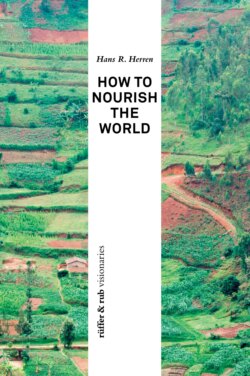Читать книгу How to Nourish the World - Hans R. Herren - Страница 5
На сайте Литреса книга снята с продажи.
ОглавлениеA world without hunger and misery
My vision of a sustainable food system for the world goes back a long way. I am a farmer’s son. My father was estate manager for the Domaine des Barges in Switzerland’s Lower Valais that was owned by the Burger und Söhne (Aargau) tobacco dynasty. The 40-hectare farm grew tobacco, potatoes and wheat.
I experienced intensive farming at first hand: it meant spraying highly poisonous insecticide to control the caterpillars of the diurnal and nocturnal moths that feasted on the tobacco leaves. It was the use of fungicides to control imported fungal diseases. They not only destroyed the pests but also eliminated beneficial insects such as bees. When I was growing up I found it quite normal, even though occasionally I also wondered whether so much poison was actually good for humans or the environment. At the time, we knew no different and it seemed as though chemicals were an essential ingredient of modern agriculture.
I spent two winters and a summer as a student at Valais Agricultural College in Châteauneuf learning what farmers needed to know about crops and fruit growing, vineyards and livestock management, i.e. that the use of agrochemicals guaranteed good harvests and a better life.
Having matriculated with a baccalaureate, I embarked in 1969 on an agronomy degree at the Swiss Federal Institute of Technology (ETH) in Zurich, with plant protection as my main subject and plant breeding as my subsidiary. At ETH plant protection almost exclusively, with one exception, meant the use of chemical methods to control damaging insects, weeds and fungi.
It was the era of the “Green Revolution”, the term used to describe the development that started in the 1960s of modern, high-performing and high-yielding crop varieties and their successful spread throughout developing countries. As a young ETH student I was seriously impressed by the higher yields that could be achieved with high-performing varieties and the massive application of agrochemicals. At the same time, however, I started to look critically at this type of agriculture and question it.
My doctoral supervisor, “the one exception”, was Vittorio Delucchi, a professor of entomology. He was a pioneer in Switzerland for integrated and biological pest management, promoting the use of natural enemies and agronomic practices rather than synthetic insecticides to control pests. Entomologists had long known that you could control pests if you could find their natural enemies, i.e. the corresponding beneficial insects. However, it seemed too complicated and expensive for the conventional agricultural industry to find these beneficials, breed them in sufficiently large numbers for commercial use and to find a suitable way to release them into the fields—despite the fact that it had been known for a long time that the method worked.
Vittorio Delucchi gave me an introduction to the research group of Robert van den Bosch at the University of California in Berkeley, which at the time was the mecca for entomologists in the field of biological pest control. In 1979, whilst at the International Institute for Tropical Agriculture (IITA) in Ibadan, Nigeria, I had an opportunity to put into practice my knowledge of the biological control of the mealybug—a pest that devastated the cassava crops.1
I remained in Africa for 27 years working in the field of biological pest control. This experience and the knowledge I gained made me realize that fundamental changes were needed to agriculture—in fact to the entire global food system.
It is an ambitious aim: a world free from hunger and misery, where everyone enjoys the same right to live in freedom with one another and in harmony with nature. A world where the boundaries of Planet Earth are respected and violence and war are outlawed. Where the needs of future generations are at the very top of the political agenda; natural resources are regenerated and preserved on their behalf. A world where energy supplies are based 100% on renewable energy sources.
In this vision, the food system plays a crucial role.
